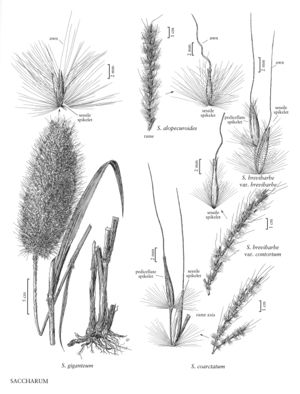Difference between revisions of "Saccharum giganteum"
FNA>Volume Importer |
imported>Volume Importer |
||
| Line 20: | Line 20: | ||
-->{{Treatment/Body | -->{{Treatment/Body | ||
| − | |distribution=Del.;Fla.;N.J.;Tex.;La.;Tenn.;N.C.;S.C.;Pa.;N.Y.;Va.;Md.;Ala.;Ark.;Ill.;Ga.;Okla.;D.C;Mo.;Miss.;Ky. | + | |distribution=Del.;Fla.;N.J.;Tex.;La.;Tenn.;N.C.;S.C.;Pa.;N.Y.;Va.;Md.;Ala.;Ark.;Ill.;Ga.;Okla.;D.C.;Mo.;Miss.;Ky. |
|discussion=<p><i>Saccharum giganteum</i> grows in wet soils of bogs, swales, and swamps. Its range extends from the eastern and southeastern United States to Central America. It is a polymorphic, primarily chasmogamous species that intergrades morphologically with the primarily cleistogamous S. trinii (Hack.) Renvoize in Central America. The combination of long callus hairs and straight awns distinguishes it from all other species of <i>Saccharum</i> in the Flora region.</p> | |discussion=<p><i>Saccharum giganteum</i> grows in wet soils of bogs, swales, and swamps. Its range extends from the eastern and southeastern United States to Central America. It is a polymorphic, primarily chasmogamous species that intergrades morphologically with the primarily cleistogamous S. trinii (Hack.) Renvoize in Central America. The combination of long callus hairs and straight awns distinguishes it from all other species of <i>Saccharum</i> in the Flora region.</p> | ||
|tables= | |tables= | ||
| Line 38: | Line 38: | ||
|illustrator=Linda A. Vorobik;Hana Pazdírková | |illustrator=Linda A. Vorobik;Hana Pazdírková | ||
|illustration copyright=Utah State University | |illustration copyright=Utah State University | ||
| − | |distribution=Del.;Fla.;N.J.;Tex.;La.;Tenn.;N.C.;S.C.;Pa.;N.Y.;Va.;Md.;Ala.;Ark.;Ill.;Ga.;Okla.;D.C;Mo.;Miss.;Ky. | + | |distribution=Del.;Fla.;N.J.;Tex.;La.;Tenn.;N.C.;S.C.;Pa.;N.Y.;Va.;Md.;Ala.;Ark.;Ill.;Ga.;Okla.;D.C.;Mo.;Miss.;Ky. |
|reference=None | |reference=None | ||
|publication title= | |publication title= | ||
|publication year= | |publication year= | ||
|special status= | |special status= | ||
| − | |source xml=https:// | + | |source xml=https://bibilujan@bitbucket.org/aafc-mbb/fna-data-curation.git/src/bb6b7e3a7de7d3b7888a1ad48c7fd8f5c722d8d6/coarse_grained_fna_xml/V25/V25_1501.xml |
|subfamily=Poaceae subfam. Panicoideae | |subfamily=Poaceae subfam. Panicoideae | ||
|tribe=Poaceae tribe Andropogoneae | |tribe=Poaceae tribe Andropogoneae | ||
Revision as of 23:02, 27 May 2020
Plants rhizomatous. Culms 1-2.5 m; nodes sericeous, hairs to 5 mm. Sheaths glabrate or glabrous; auricles absent; ligules 2-6 mm; blades usually 35-70 cm long, 8-30 mm wide, adaxial surfaces glabrous or pilose. Peduncles 40-80 cm, pilose; panicles 6-15 cm wide, oblong or lanceolate; rachises 15-30 cm, pilose; lowest nodes densely pilose; primary branches 2-13 cm, ascending or appressed to the rachises; rame internodes 2-5.5 mm, pilose. Sessile spikelets 4.2-6 mm long, 0.8-1.1 mm wide, straw-colored. Callus hairs (7)15-20(25) mm, longer than the spikelets, straw-colored or brown; glumes usually glabrous; lower glumes smooth, indistinctly 5-veined; lower lemmas 3-5 mm, without veins; upper lemmas 2.5-3.5 mm, 1-veined, entire; awns 12-26 mm, straight or curved, terete basally; lodicule veins sometimes extending into hairlike projections; anthers 2. Pedicels 2.5-5 mm, pilose. Pedicellate spikelets similar to the sessile spikelets, except frequently pilose. 2n = 30, 60, 90.
Distribution
Del., Fla., N.J., Tex., La., Tenn., N.C., S.C., Pa., N.Y., Va., Md., Ala., Ark., Ill., Ga., Okla., D.C., Mo., Miss., Ky.
Discussion
Saccharum giganteum grows in wet soils of bogs, swales, and swamps. Its range extends from the eastern and southeastern United States to Central America. It is a polymorphic, primarily chasmogamous species that intergrades morphologically with the primarily cleistogamous S. trinii (Hack.) Renvoize in Central America. The combination of long callus hairs and straight awns distinguishes it from all other species of Saccharum in the Flora region.
Selected References
None.
